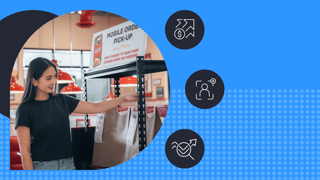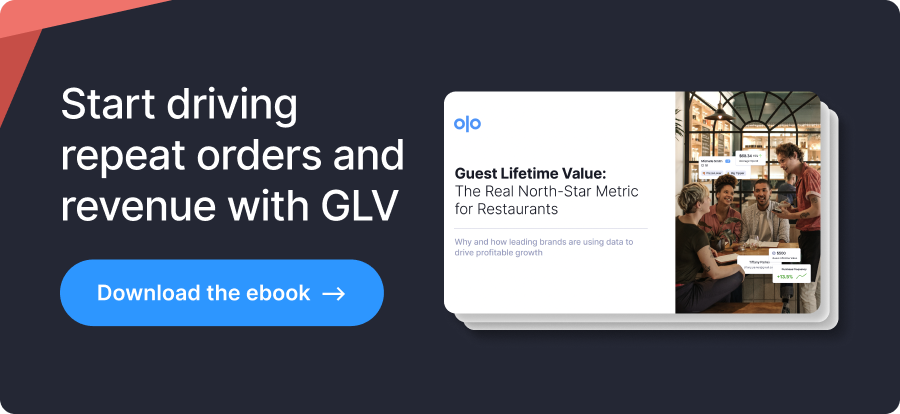
This article outlines:
What is Guest Lifetime Value (GLV)?
Why GLV is Essential for Restaurants
How restaurants can maximize guest lifetime value
Historically, restaurant leaders won by driving transactions—keeping tabs on cover counts and obsessing over same-store sales. Winning didn’t require that you knew who was dining with you, why, or how often. Some team members knew the guests, but that information didn’t get disseminated to all parts of the business. From a practical perspective, guest data often lives with specific team members, but isn’t brought into finance, marketing, culinary, labor, or real estate decisions.
There has been a fundamental shift in the restaurant industry brought on by changing consumer preferences for personalization (think individualized recommendations from Netflix, Amazon, DoorDash, and Instagram) and the pandemic driving tech adoption everywhere. Winning restaurant brands in every category are personalizing the guest experience to maximize lifetime value.
Before we dive into why and how, it’s important to have a basic understanding of guest lifetime value, also known as GLV.
What is Guest Lifetime Value (GLV)?
Guest lifetime value is the estimated profit generated from each individual guest from the first visit through the last. In other words, it’s how valuable a guest is to your business, not just on a transaction basis, but with regard to their recency, frequency, and monetary spend across the entire relationship.
Note: “Lifetime” does not refer to the person’s actual lifespan. No “til death do us part” metrics here.

Why GLV is Essential for Restaurants
Restaurant brands must now harness and act on guest data to remain competitive. In fact, restaurant industry analysts and investors are increasingly considering guest-level economics over same-store sales data.
Given the accelerated adoption of data-driven technology across the restaurant industry, it’s safe to say that any brand that doesn't prioritize GLV is now at risk.
Whether you recognized it or not, this shift did not happen overnight. E-commerce and entertainment giants like Amazon, Netflix, and Disney have been maximizing GLV for years with highly personalized user experiences—a process mirrored perhaps more obviously on social media and through digital advertising. As a result, we as consumers have come to expect things like email campaigns tailored to our unique interests, promotions triggered by our recent purchases, and recommendations based on our viewing history.
The restaurant industry is lagging behind on this front, largely because of legacy POS systems, consumer networks that “own” the guest data, and other fragmented point solutions. These blockers make it impossible to know the value of each individual guest because the data exists only in disconnected silos.
The future of the restaurant industry lies with those brands that are taking a page out of the retail playbook. Restaurants can learn from the likes of e-commerce by harnessing actionable guest data with a single integrated system and applying the GLV metric to operations, marketing, and business.
With GLV, restaurant brands can:
- Fine-tune day-to-day operations through revealing insights, such as driving factors for guest loyalty and maximizing them
- Analyze different guest segments based on individual behaviors
- Quantify results of marketing dollars spent, staff training, menu optimization, real estate selection, and more
- Discover exactly where and why guests spend money
Given that acquiring a new guest costs far more than retaining an existing one, increasing the value of your existing guests—with the support of comprehensive guest data—is a critical way to drive growth.
Hear leaders from bartaco, California Fish Grill, and First Watch share how guest lifetime value is changing the way they run their restaurants and driving better results.
How Restaurants Can Maximize Guest Lifetime Value
Leading brands have proven that restaurants can maximize guest lifetime value, increase frequency and retention, and, ultimately, boost revenue by focusing on individual guest behavior. In the end, the brands that know their guests best and do something with that intel will come out on top.
By harnessing data and analytics—from 100% of guests, not just loyalty or rewards club members—restaurants can tailor every action, communication, and business decision to the behaviors of their most valuable guests.
Imagine ...
- Knowing exactly who’s behind every curbside order and if they’re also dine-in regulars
- Sending targeted SMS messages at just the right moment that feel like they’re coming from a friend
- Targeting lookalike audiences for the top 20% of your guests on paid search and social media (proven to drive down guest acquisition costs to under $1)
- Alerting managers which table touches to prioritize during a busy shift
- Having a regular’s favorite drink prepared upon arrival
In the end, the brands that know their guests best and do something with that intel will come out on top.
Moving from Transactional Thinking to Guest Thinking
At the end of the day, transactions still matter. After all, C-level executives continue to get grilled over things like same-store sales and box economics. But, those are output metrics. Input metrics that can be controlled and influenced by focusing on individual guest behavior—things like guest frequency, recency, and spending—drive transactions and therefore profitability.
Transitioning from transactional thinking to guest thinking changes the game for everyone on the team. C-level restaurant executives have to shift their focus from same-store sales to Customer Cohort Charts. Finance now concentrates on guest economics instead of box economics. Marketing starts looking at lifetime return on ad spend versus return on ad spend. The list goes on.
It may sound like a big undertaking, and it is. But budgets are tight, and the last thing you want to do is waste time and money attracting low-value guests. When you make every business decision with your most valuable guests in mind, you can ensure that every dollar spent will have a high ROI and drive profitability for your business long-term.
Ready to Make the Shift?
To effectively drive and leverage GLV, restaurant brands need to be able to access 100% of guest data from a single view and inject it into every part of the business—from operations to marketing. Only then, can they individualize each interaction and make data-driven business decisions that boost revenue, guest loyalty, and operational efficiency, all while bringing acquisition costs down.
The path forward for restaurants is building a profitable future with data and those who focus on guests (and their lifetime value) will win. So the question becomes: Does everything in your brand actually revolve around the guest?
Contact us to find out how Olo can help your brand unlock and maximize guest lifetime value.

